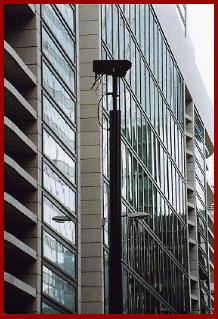| ||||||||||||||||||||||||||||||
Welcome to the | ||||||||||||||||||||||||||||||
 | ||||||||||||||||||||||||||||||
 | ||||||||||||||||||||||||||||||
The complete A to Z ... | ||||||||||||||||||||||||||||||
Although all fibre optic (or optical fibre if you prefer) signal transmission works on the same principle, there are actually two distinct methods available (exc. plastic!). The basic principle is that with a transmitter at one end of an optical fibre, the injected video signal is ‘modulated’ onto a light beam carrier that ‘shines’ down the fibre to be decoded at the other end by a receiver (clear so far?). Now because an optical fibre is said to have a very large ‘bandwidth’, this means that a normal video signal which requires a certain amount of space for transmission, can actually be accommodated many times over down just one single fibre. This opens up the possibility for transmitting a large number of video, along with audio and data signals down a single optical fibre (signal multiplexing) if required. Where it tends to get a little bit complicated is that this ‘multiplex’ approach is generally cheap on fibre but expensive on equipment. Using seperate fibres with individual transmitter / receiver units is overall a much cheaper (and less risky option) for relatively short fibre runs, of up to 5 kilometres. The basic rule with all fibre optics is, being immune to any induced interference or hum (if you do see it, it’s generally been picked up by the ‘copper’ at each end!), within the accepted range of the fibre, what you see at the back end, is pretty much the same as what came out of the camera. The two main techniques for transmission are ‘Multimode’ for medium distance (normally up to 5 km.) which uses a relatively “thick” fibre (50 microns in diameter - if you can call that thick!!), and ‘Singlemode’ which uses a frighteningly thin fibre to boost ‘straight line’ signal propogation up to many dozens of kilometres. Cables are available as ‘loose tube’ with fibres free moving inside an inner tube, or tight jacket where each fibre is held as snug as a ....! All versions are available with varying degrees of additional protection, although stiff outer plastic armouring is the preferred choice for most applications. At a basic level, being able to pull through a single cable containing a multitude of thin optical fibres, opens up enormous possibilities for developing a very flexible CCTV and communications network, but of course, if the worst happens and the cable is damaged, the cost to repair can be quite considerable. | ||||||||||||||||||||||||||||||
 | ||||||||||||||||||||||||||||||
IMPORTANT: No material may be reproduced, copied or redistributed from this site, © doktorjon.co.uk 2004 - 2008 Homepage...:...Gateway...:...Technical Gateway....:....Quickfind Index....:....Equipment Directory | ||||||||||||||||||||||||||||||

